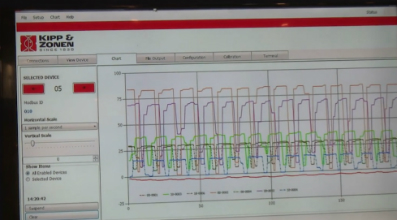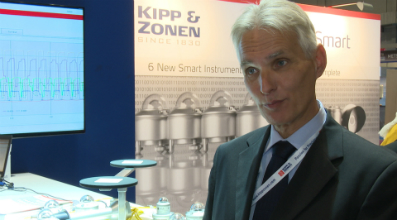We picked the Meteorological Technology World Expo as the perfect event for the launch because the whole meteorological industry could be informed at once. We gave the launch an extra dimension by having a live demonstration. Ten smart instruments connected to one RS-485 to USB interface, with the output visualised on a large screen by our new SmartExplorer software. To make the readings a bit more interactive we had a rotating shadow circling over the instruments.

First feedback about the expanded Smart range
Not surprisingly, the demonstration attracted a lot of attention and raised questions. A perfect opportunity to explain what the benefits are of measuring with smart instruments. The first feedback has been very enthusiastic because to actually see it happen - the instruments measuring radiation directly displayed on a screen – made everyone quickly understand the advantages.
The fast response time for example. You could see on the spot that as soon as an instrument was shaded the graph dropped right away. Smart instruments are up to 2.5 times quicker.
Meteorological customers recognised that the expansion with smart pyrgeometers now means you can read a full solar monitoring station on one digital RS-485 input. That’s all it takes. You can combine all the SMART radiometers on one Modbus® network!
Passive pyrgeometers produce a ‘net’ output signal. You have to record the internal temperature and apply an equation to derive the actual downward (or upward) long-wave irradiance. The Smart SGR3 and SGR4 perform this calculation internally in real-time, avoiding possible post-processing errors.
The fact that the individually measured temperature correction is programmed into the new SMP21, SMP22 and SGR4 instruments (as with the existing SHP1) was confirmed as one of the main benefits. For our highest level passive pyranometers, CMP21 and CMP22, you need to correct measurement data yourself for the best accuracy. With the Smart range it’s all done internally making the output of the SMP21 and SMP22 more accurate and over a wider temperature range, from -40 to +70 °C.
The SUV5 total UV radiometer not only has internal temperature correction, but also linearisation. This makes it especially suitable for monitoring high power lamps used in solar simulators and environmental test chambers.
Ready to order
In the coming weeks we will finish documentation such as instruction sheets and manuals, and start production of all the new smart instruments to have the first batch ready to deliver in the new year.
Good to know is that all new Smarts will have the integrated desiccant that we introduced with the CMP10 two years ago. The desiccant lasts up to 10 years. This means that it’s no longer necessary to inspect or change drying cartridges, lowering the maintenance costs.
But what was even more appreciated is that all these instrument will have a 5 year warranty! We now have over 3 years of experience with Smart instruments since the launch of the SMP3 and SMP11 pyranometers and we are confident that the full range of Smarts will have the same proven reliability as our CMP, CGR and CUV instruments.
SmartExplorer software

With the expansion of our Smart range we have also improved the computer software. SmartExplorer has a very nice logging function and allows you to view settings and monitor the measurements of your Smart instruments. You can choose to see the digital values or to have a graphical presentation. A unique feature of the SmartExplorer software is that it can recognise an instrument with any communication settings directly after power on!
Smart benefits for solar energy
Although it was MTX we selected for the introduction, this expansion of smart radiometers is also extremely interesting for solar energy projects. One main benefit for solar energy is the perfect match of the Modbus® RS-485 communication to solar energy monitoring systems. Moreover, multiple sensors can be connected to one RS-485 port / Modbus® input. Thanks to the high quality 24-bit analogue-to-digital converter all sensitive signals are handled inside the instrument and the digital output allows for cables up to a kilometre long.
Specifically for PV applications the fast response time is a big advantage. This makes comparison over short intervals between the output of a PV plant and the measured incoming solar irradiance more accurate.
Product information and specifications

We have published the specs on the product pages of our website. Furthermore we have several documents available in our download centre such as the information flyer, the software manual, the SMP instruction sheet and the latest newsletter. More will be available in the next coming weeks.
Most importantly, you can download the SmartExplorer software for free, and it’s compatible with all our existing Smart instruments.
Contact your Kipp & Zonen office or local distributor for more information on prices and availability.
I’m really happy with the feedback received at Meteorological Technology World Expo, it confirms that Smart instruments are the future.
Blog written by Ruud Ringoir, Product Manager at Kipp & Zonen